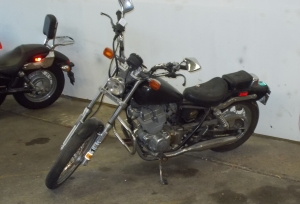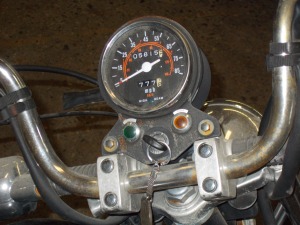The saddest Honda I’ve ever seen was parked alone in isolation, as if the other motorcycles were avoiding it.
I was wandering the service department of Coleman PowerSports in Falls Church Saturday morning, waiting for Linda’s Vespa to get its annual safety inspection sticker. (Usually we go to Crossroads Cycle for inspections, but I was in a hurry and Coleman is closer.)
 All bikes, especially older ones, have a story. Maybe that’s why I was drawn to it.
All bikes, especially older ones, have a story. Maybe that’s why I was drawn to it.
It was a dusty 250cc Honda Rebel, a 1986 model, as I discovered. The official designation is CMX 250, introduced in 1985 and still in production. They’re essentially small two-cylinder cruisers with a dash of Harley style. They’re good entry-level bikes, and you often see them used in Motorcycle Safety Foundation classes.
Oh, but this one has been badly treated – torn saddle, mirrors pointing every which way and surface rust everywhere. Someone had painted the gas tank flat black, giving it sort of a chopper look, and added an aftermarket engine guard.
 But the right-side cover is missing, exposing the glass cartridge fuse block. The rear blinkers are broken, one gone, and both brake levers are curiously curled outward, on purpose for some obscure, ill-advised reason.
But the right-side cover is missing, exposing the glass cartridge fuse block. The rear blinkers are broken, one gone, and both brake levers are curiously curled outward, on purpose for some obscure, ill-advised reason.
There are 5,815 miles on the odometer, pretty low for a 29-year-old bike. The last safety sticker had been issued in 1996. A George Mason University parking sticker on the rear fender expires in 1992. Next to that, a small dealer sticker: K&R Honda, Bellerose, New York*.
I see a bronze fob attached to the ignition key and turn it over; TOYKO TOWER it says on one side, with the reverse covered in English and Japanese writing. This is a memento, all the way from Japan, of the Eiffel-Tower-shaped communications rig in Tokyo.
And yet, at long last, the little Honda is here, sitting hopefully waiting for service.
Linda’s Vespa is soon brought round with a new sticker and I pay the inspection fee.
“I have to ask, what’s the story with that Honda?” I say to the guy behind the counter.
 “Oh,” he says, “Guy brought it in wanting to get it fixed up. We looked at it and started adding up what was wrong and the bill got too high. More than it’s worth, probably. He’s trying to decide what to do.”
“Oh,” he says, “Guy brought it in wanting to get it fixed up. We looked at it and started adding up what was wrong and the bill got too high. More than it’s worth, probably. He’s trying to decide what to do.”
It’s a common story and probably explains why the Honda has been neglected for so long. As David Snow used to point out in Iron Horse magazine, Japanese bikes don’t seem to hold their value.
One of the magazine’s recurring features was a monthly page on discarded Hondas, Kawasakis, Suzukis and Yamahas found on the streets of New York City. The owners had simply parked them and walked away. You could find literally dozens of them, but never a castoff Harley, BMW, Triumph, Ducati or other foreign bike.
I take my leave, briefly and irrationally considering the economics of buying the Honda and saving it. It would make no sense, of course. Linda’s interested in scooters, not motorcycles, and the Honda is too small for me. Besides, I still have my own restoration project, a 1965 305cc Honda Dream that’s at home.
 So I left the Honda there, hoping its owner will find the wherewithal to get it back on the road. It obviously holds some good memories for someone; perhaps there is still time for a few more.
So I left the Honda there, hoping its owner will find the wherewithal to get it back on the road. It obviously holds some good memories for someone; perhaps there is still time for a few more.
* — no longer in business, according to an Internet search. Curiously, it was located not far from Queens.



I heard hope in your post. Hope for motorcycles and always hope for people as we have one more spin in us and more memories to make!
Kenny and Roger (K&R) Honda in Bellerose. My go to place for parts and service